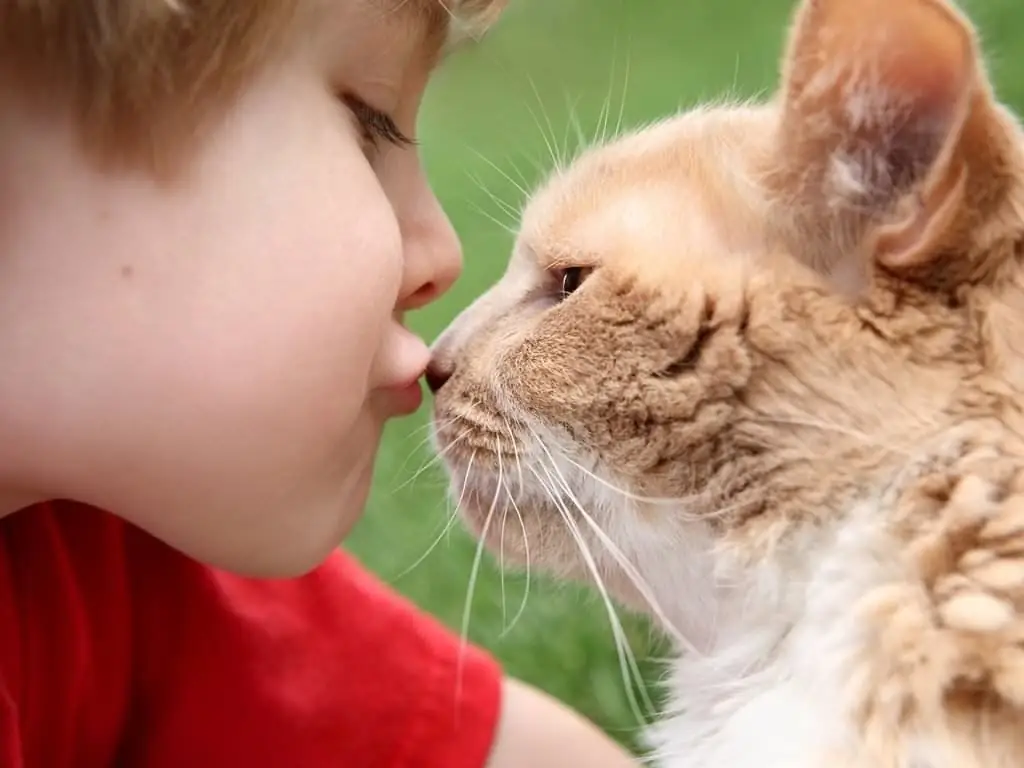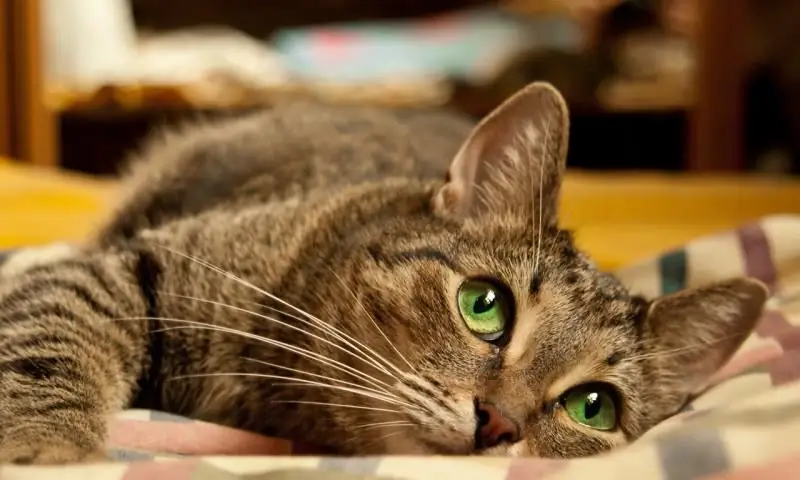
Table of contents:
- Author Bailey Albertson [email protected].
- Public 2023-12-17 12:53.
- Last modified 2025-06-01 07:32.
Cat scratches and bites: dangerous consequences

Cat owners often ignore scratches and cat bites. But in a number of situations, these injuries can cause serious human diseases, most of which can be avoided if you have the appropriate information.
Content
- 1 Dangerous effects of cat scratches and bites
-
2 What to do if a cat scratches or bites
- 2.1 First aid
- 2.2 If edema and redness appear at the site of the bite
- 2.3 Folk remedies for removing puffiness
- 2.4 Possible complications
-
3 Medical care for a cat bite
-
3.1 Immunization after cat bites
- 3.1.1 Rabies
- 3.1.2 Video: Human Rabies Symptoms
- 3.1.3 Tetanus
- 3.1.4 Video: the effects of animal bites
- 3.2 Antibiotic therapy
-
3.3 Septic conditions caused by a cat bite
- 3.3.1 Infection with Capnocytophaga Canimorsus
- 3.3.2 Infection with methicillin-resistant strains of Staphylococcus aureus
- 3.3.3 Pasteurellosis
- 3.4 Felinosis
-
- 4 Preventing cat bites
Dangerous effects of cat scratches and bites
In most cases, the domestic cat, by biting or scratching, controls the force of the impact, and superficial damage disappears without a trace. According to statistics, in most cases cats attack their hands, especially the right one, as well as the face. If the cat is very angry or frightened, it can cause deeper damage. Since this animal does not possess powerful jaws, like a dog, it is not capable of inflicting large, life-threatening lacerations.
The following dangerous consequences of cat bites and scratches can be distinguished:
-
The cat's teeth are very sharp, and the wounds inflicted by them are characterized by depth, narrow wound canal and high bacterial contamination, which creates favorable conditions for the development of wound infection. According to statistics, injuries after cat bites have signs of bacterial inflammation in 80% of cases, which contributes to the development of:
- abscess of soft tissues - limited purulent inflammation;
- phlegmon of soft tissues - diffuse purulent inflammation;
- panniculitis - inflammation of the subcutaneous tissue;
- purulent arthritis and osteomyelitis - purulent inflammation of the joint cavity and articular surfaces, as well as bone if the joint is damaged by a bite;
- generalized infectious process and septic condition in cases of immunodeficiency in a patient, a special composition of the infecting flora, as well as untimely provision of medical care.
- In some cases, the tendon or joint capsule, usually on the hand, as well as the vessels and nerves, may be damaged.
-
Injuries caused by cats, especially strangers and stray cats, can lead to the development of infectious diseases:
- rabies;
- tetanus;
- felinosis - an acute infectious disease from the bartonellosis group;
- pasteurellosis - a rare infectious disease that affects the skin and subcutaneous tissue, joints and skeletal system;
- infection with methicillin-resistant strains of Staphylococcus aureus;
- Capnocytophaga Canimorsus (capnocytophage infection).

Interacting with an angry or scared cat will result in scratches and bites
What to do if your cat is scratched or bitten
For a preliminary assessment of the consequences of injury, it is important to pay attention to the associated factors:
- the conditions under which the cat attacked, especially how much time has passed since then;
- what is known about the bitten cat;
- whether she was provoked to attack;
- where is the cat now;
- the presence of allergic reactions in a bitten person;
- the presence of concomitant pathology;
- clarification of the fact of taking medications at the current moment and their nature;
- whether the person has been vaccinated against tetanus.

It is important to collect information about the bitten animal, even if it does not belong to the bitten person
First aid
It is extremely important to quickly and thoroughly clean the wound or scratch. To do this, apply:
-
Washing the wound with running water and laundry soap for 5-10 minutes. It was established in the laboratory that with a quick and thorough washing of the wound in experimental animals, it was possible to remove the rabies virus from it in 90% of cases, but since there is still a 10% chance of contracting a fatal disease, this does not exempt from immunization when bitten by an unvaccinated or unfamiliar cat.

Laundry soap bars When treating a wound, laundry soap alkalizes the environment and inactivates the rabies virus, its foam effectively removes contamination from the wound
- Washing the injuries with a solution of hydrogen peroxide - this contributes to both disinfection and stopping bleeding.
- Treatment with an aqueous solution of chlorhexidine.
- Treatment of the edges of the wound with alcohol solutions of iodine or brilliant green. It is important to act carefully and not to allow solutions to enter the wound itself.
- Bandage application. You can use pharmacy dressing napkins that have a surface that does not stick to the wound and does not injure it when changing the dressing.
If swelling and redness appear at the site of the bite
The presence of edema and redness in the area of the wound indicates its infection. Such damage requires regular dressings using:
-
hydrogen peroxide;

Hydrogen peroxide Hydrogen peroxide has antiseptic properties
- an aqueous solution of chlorhexidine;
-
Levomekol ointment;

Levomekol Levomekol ointment is used on purulent wounds
- alcohol solutions of iodine and brilliant green for processing its edges;
- Solcoseryl and Panthenol to speed up healing when the wound is cleared of pus.
Usually, a small edema occurs immediately after injury - this is how the tissue reaction to injury manifests itself, this is post-traumatic edema. If it increases within 1-2 days, this indicates the spread of the infectious process and the need to prescribe antibiotic therapy. If during the treatment of the wound the removal of bacteria is achieved, then the edema subsides the next day with a small size of the damage, after which it decreases and dries up. But this applies for the most part to scratches or open bite wounds, since in most cases, with cat bites, skin damage is minimal, while deeper tissues can be contaminated with microflora. In these cases, to stop the infectious process, only the treatment of the wound is indispensable.
In cases of development of infection in the wound, the edema will grow in dynamics, causing a feeling of pain and distention and taking on a completely different character. At the same time, the edematous fluid contains a large number of immunocompetent cells that have come to the focus of inflammation. In some cases, in people with hypersensitivity, edema may be of allergic origin. It is usually accompanied by itching, rashes on the skin, which may precede the onset of anaphylactic shock. It is necessary to take an antihistamine (Suprastin, Tavegil) and go to the doctor.

Increased edema requires a visit to the doctor and initiation of antibiotic therapy
Folk remedies for removing puffiness
Folk remedies for removing puffiness include:
- vodka compress on the edema zone;
- treatment of the skin around the wound with alcohol tincture of calendula;
- compresses with chamomile infusion: pour a tablespoon of dry chamomile with a glass of hot, but not boiling water and leave for half an hour;
- compresses with oak bark infusion: pour a salt spoon of oak bark with a glass of boiling water, leave for 1 hour.
Possible complications
There are a number of factors that place a person at an increased risk of complications from cat bites:
- puncture character of the wound: slight damage to the skin, narrow deep wound channel;
- providing medical assistance later than 12 hours after the bite;
-
state of immunodeficiency:
- HIV infection;
- condition after organ transplant;
- taking immunosuppressants, including corticosteroid hormones;
- chronic alcoholism;
- diabetes;
- long-term edema;
- a bite on the face, hand or foot;
- insufficiency of liver and kidney function;
- heart failure;
-
peripheral arterial disease:
- atherosclerosis;
- aortoarteritis;
- thromboangiitis;
- Raynaud's disease.
Wound complications are due to both the nature of the flora that got into the wound and the location of the damage:
-
With a limited focus of purulent inflammation, abscesses occur. If the inflammation is not delimited and more and more adjacent tissue sites are involved, phlegmon occurs. In this case, the following are observed:
- fever;
- headache;
- muscle pain;
- an increase in regional lymph nodes.
- Perhaps the development of sepsis, the release of microbes into the bloodstream and the creation of distant foci of infection, they are called septic.
- The causative agents of wound complications are streptococci, staphylococci, enterococci, Escherichia coli and many other microorganisms present both in the mouth of a cat and on human skin.
You should go to a medical facility if:
- bleeding from the wound persists for a long time;
- impaired mobility in the joint;
- impaired sensitivity in the bite area;
- trauma caused by an unknown or unvaccinated animal;
- swelling increases, fever appears;
- the person has not been vaccinated against tetanus for the last 5 years;
- there is an immunodeficiency state.

For people with immunodeficiency, both cat and dog bites are dangerous
Cat bite treatment
The medical institution produces:
- interrogation of the bitten person to collect information about himself, the bitten animal and the circumstances of the attack;
-
qualified examination of the damage caused, the following are assessed:
- their localization;
- depth;
- involvement of underlying tissues, blood vessels, nerves;
- the presence of signs of wound infection;
- sampling of material for bacteriological examination in the presence of purulent inflammation in the wound (with late treatment);
- washing the wound from a syringe with saline, which helps to remove microorganisms and possible foreign bodies (if the wound is recently inflicted);
-
surgical treatment of the wound - with a few exceptions, bitten wounds are not sutured, since this can turn into suppuration, it is allowed to suture wounds only on the face and neck, since in these areas a good blood supply prevents the development of infection, with late treatment with the development of complications, assistance is provided in a hospital:
- opening and treatment with antiseptics of a purulent focus;
- creating conditions for the outflow of discharge;
- the appointment of antibiotic therapy;
- X-rays, for example, if there is a suspicion that a cat tooth is left in the wound or for damage to bone tissue;
- immunization against rabies and tetanus;
-
consultations of specialized specialists:
- traumatologist - if the hand is damaged;
- plastic surgeon - for injuries to the face and neck;
- psychologist - for post-traumatic stress in children;
- prophylactic or therapeutic antibiotics;
-
determination of indications for hospitalization, they can be:
- fever;
- septic condition;
- severe swelling;
- continued spread of inflammation;
- loss of joint function;
- immunodeficiency;
- non-compliance with medical recommendations.
Immunization after cat bites
When providing medical care to persons bitten by animals, indications for immunoprophylaxis of rabies and tetanus infection are determined.
Rabies
Rabies is absolutely fatal to humans. If symptoms of the disease appear, the death of the infected is inevitable.

Rabies virus infection is characterized by severe damage to the central nervous system, threatening death
When analyzing the cases of deaths from rabies, it is revealed that:
- 75% of individuals voluntarily refused immunization;
- in 12.5% of cases, the reason was self-termination of a series of vaccinations and failure to comply with the prescribed restrictions associated with them;
- in other cases, the reason for the development of infection was an incorrect assessment of the circumstances and an incorrect determination of indications for immunization.
The risk of infection is considered insignificant, and the vaccine is not administered if the bitten cat has been vaccinated against rabies within a year (but not later) and has no clinical manifestations. Even if the animal is vaccinated, it is monitored for 10 days; and if he develops symptoms of rabies, the bitten person should immediately begin immunoprophylaxis.
The most dangerous is the localization of bites in:
- facial area;
- neck area;
- areas of the hand and fingers;
- multiple locations (multiple bites).
In these cases, an abbreviated course of 3 vaccinations is carried out (while observing the cat), since in some cases even vaccinated animals can become a source of rabies infection, for example, if the rules of vaccination are neglected, the antigenic properties of the vaccine are reduced. If during the 10-day observation period the cat remains healthy, the vaccination course is stopped.
There are no contraindications to rabies immunization when bitten by animals, given its absolute lethality. Rabies vaccination is carried out by the doctor of the antirabies aid center (order of the Ministry of Health No. 297 of 7.10.1997).
The vaccine is administered in a dose of 1 ml as an intramuscular injection on the day of treatment (0th day); and also on the 3rd, 7th, 14th and 30th days from the beginning of the course. Some patients are additionally immunized on the 90th day. The vaccine is administered:
-
adults and adolescents in the deltoid muscle of the shoulder;

Shoulder grafting The administration of the rabies vaccine to adults and adolescents is carried out in the shoulder
- children - in the outer surface of the thigh.
The modern rabies vaccine is well tolerated, in 0.02-0.03% there are mild allergic reactions, mainly rash.
After vaccination against rabies, for its effectiveness, it is vital that restrictive measures are observed during the course of vaccination, as well as 6 months after its completion. Strictly contraindicated:
- taking alcohol;
- overstrain and overwork;
- exposure to high temperatures leading to overheating (prolonged sun exposure, sauna visits);
- exposure to low temperatures leading to general hypothermia.
The effectiveness of the vaccine is 96-98%, but if its introduction is started no later than two weeks with a cat bite. Antibodies to the virus appear 14 days after immunization and form intense immunity by 30-40 days. Post-vaccination immunity lasts for 1 year. In persons with immunodeficiencies, as well as those receiving immunosuppressive therapy, the titer of anti-rabies antibodies must be monitored.
In cases where the rapid development of infection is expected, the administration of the vaccine is combined with the administration of anti-rabies immunoglobulin - ready-made antibodies:
- the dangerous localization of injuries described above;
- when there are several bites;
- in cases of deep bites, in which a vessel trauma and bleeding occurred.
Rabies immunoglobulin is administered within the first 3 days after injury, preferably in the first 24 hours, while half of its dose is used by irrigating the wound or chipping off its edges.

Raising a kitten, you should wean him from biting
Video: symptoms of rabies in humans
Tetanus
When a cat is bitten, emergency prevention of tetanus infection is relevant, it must be carried out within the first 20 days from the day of the bite.
For emergency prevention of tetanus use:
- adsorbed tetanus toxoid - for the formation of active immunity, antibodies-antitoxins are formed, which neutralize the damaging toxin secreted by the causative agent of tetanus;
- equine tetanus serum - contains ready-made horse antibodies, creates passive immunity;
- anti-tetanus human immunoglobulin - also creates passive immunity.
The administration of drugs for the emergency prevention of tetanus infection is very differentiated, and the choice scheme is based either on determining the level of specific antitoxin in the blood of the bitten person, or based on his vaccination history, since tetanus vaccination is included in the national vaccination schedule. It is unequivocal that if an adult has not been vaccinated against tetanus for the last 5 years, prophylaxis is necessary.
Video: the consequences of animal bites
Antibacterial therapy
Antibiotic therapy is used for prophylaxis in all cases, except those where the damage is superficial and can be easily treated. Also, antibiotic therapy is not prescribed if more than 2 days have passed since the bite, and there are no data for the development of both wound and systemic infections.
For deep injuries affecting the tendons, joints, bone tissue, antibiotic treatment is prescribed immediately to all victims. The best preventive effect is given by prescribing and taking the drug in the first 2 hours after the bite.
The following antibacterial agents are used for pet bites:
-
the drug of choice is Amoxiclav, which is a combination of amoxicillin with clavulanic acid, since the spectrum of action of amoxicillin covers both the diversity of the microbial flora that lives in the mouth of the bitten animal and the flora found on the skin of humans;

Amoxiclav Amoxiclav is an antibacterial drug that combines the action of amoxicillin with clavulanic acid
-
if a person is allergic to antibiotics of the penicillin series, then they are prescribed:
- doxycycline, sometimes with metronidazole;
- clindamycin with a fluoroquinolone antibiotic;
- clindamycin with cotrimoxazole - in children;
-
in pregnant women it is possible to use:
- ceftriaxone;
- cefuroxime acetyl;
- cefpodoxime.
Antibiotic therapy is prescribed for prophylaxis with timely treatment for 5 days or for treatment with delayed treatment for 7-10 days.

A small cat can bite if he has few toys
Septic conditions caused by a cat bite
A cat bite can transmit a number of infectious agents that cause septic conditions in humans. Therefore, antimicrobial prophylaxis is important for more than just preventing wound infections.
Capnocytophaga Canimorsus infection
The causative agent Capnocytophaga Canimorsus (capnocytophageal infection) lives in the mouth of dogs and cats and is a danger to people with immunodeficiency. This infection is characterized by inhibition of phagocytosis and neutrophil motility.
Clinical manifestations include the development of:
- endocarditis - inflammation of the heart valve apparatus;
- meningitis - inflammation of the meninges;
- vasculitis - vascular inflammation with the formation of a characteristic spotty rash;
- septic shock (in severe cases, death is possible as a result).
Infection with methicillin-resistant strains of Staphylococcus aureus
This type of infection is due to the fact that methicillin-resistant community-acquired strains of Staphylococcus aureus are easily transmitted from person to person, and from person to pet and vice versa.
Usually affected:
- soft tissues;
- leather;
- lungs - development of severe staphylococcal pneumonia is possible.
Therefore, in case of an unfavorable epidemiological situation for this pathogen, doctors use doxycycline, clindamycin and cotrimoxazole in a preventive regimen. With a severe infection, linezolid and tedizolid are used as reserve drugs.
Pasteurellosis
Pasteurellosis is caused by the anaerobic bacilli Pasteurella, which lives in the mouth of cats and dogs. Infection can occur from bites and scratches, or from licking. The risk group includes persons with immunodeficiency states. The disease is manifested by development:
- necrotizing fasciitis;
- septic arthritis;
- osteomyelitis;
- sepsis and septic shock;
- liver damage;
- rarely - endocarditis and peritonitis in patients on outpatient peritoneal dialysis.
Felinosis
Felinosis, or benign lymphoreticulosis, is also called cat scratch disease. The causative agent is Bartonella henselae. Felinosis is an acute infectious disease, which is characterized in most cases by a mild course and goes away on its own. The source of infection is infected cats, between which the pathogen is transmitted through fleas, this is associated with the seasonality of the disease with a peak in summer and autumn. A sick person is not dangerous for others. The most vulnerable are children and adolescents under 18-20 years old, everyone is susceptible to infection.

The primary focus with felinosis looks like a papule, which then suppurates
Felinosis has the following manifestations in combination with previous trauma from the cat:
- primary focus - is formed in about half of the cases; bumps (papules) form on the skin at the site of the cat's injury, which then fester;
- an increase in regional lymph nodes on the side of the lesion - inflammation occurs in the lymph nodes with the formation of cell granulomas, small abscesses, sometimes with fistulas, as well as necrosis of a characteristic "stellate" shape; with strong immunity, the infectious process is interrupted at the level of regional lymph nodes, and further spread of the pathogen does not occur;
- rare, but fever may occur;
- in persons with immunodeficiency, damage to internal organs is possible.
The incubation period is on average 1-2 weeks, but can vary from 3 days to 6 weeks.
Felinosis has two forms of the course of the disease:
-
Typical shape with 3 well-defined periods:
- Initial - the appearance of a primary focus, often a person does not pay attention to it.
- The height of the disease - after 3 days, papules suppuration begins, followed by their drying. This can take 1-3 weeks. After 10-14 days, inflammation of the regional lymph nodes occurs with the involvement of the entire group or a single node, which becomes enlarged, painful on palpation. The tissue around the affected lymph nodes does not undergo changes. The inguinal and axillary groups of lymph nodes are more often affected. The phenomena of regional lymphadenitis persist from 1 week to 2 months and may be accompanied by fever and symptoms of intoxication (weakness, general malaise, muscle and headaches). Enlargement of the liver and spleen may be observed.
- Convalescence - the prognosis of the disease in the overwhelming majority of cases is favorable, the person is recovering.
-
The atypical form is characterized by many variants of the course of the disease:
- Ocular - develops when the pathogen enters the conjunctiva of the eye, in most cases as a unilateral lesion with the formation of ulcers and granulomas on the mucous membrane of the eye, its hyperemia, as well as pronounced edema of the eyelid; inflammation occurs in the submandibular and parotid lymph nodes.
-
Neuroretinitis - characterized by a pronounced one-sided decrease in visual acuity against the background of a satisfactory condition of the patient. At the same time, the examination reveals:
- edema of the optic nerve disc;
- changes in the retinal vessels, as well as the formation of stellate necrosis on it.
- Damage to the liver and spleen - the formation of inflammatory cell granulomas in these organs occurs, and various groups of peripheral lymph nodes are often involved. The disease is characterized by wave-like fever and changes in blood biochemical parameters, reflecting the course of inflammation in the liver.
- Bacillary angiomatosis - often occurs against the background of immunodeficiency. A nodular skin lesion develops, the liver, spleen, and peripheral lymph nodes can also be affected.
-
Rare atypical forms - development is possible:
- pleurisy;
- osteomyelitis;
- endocarditis;
- erythema nodosum - skin lesions.
Diagnosis is based on anamnesis data (previous lesions caused by the cat), the presence of typical clinical signs and is verified by laboratory diagnostics, mainly by PCR and ELISA.

In the midst of the disease, an increase in regional lymph nodes appears on the affected side
Treatment will reduce the duration of the disease, apply:
- doxycycline;
- fluoroquinolones;
- macrolides;
- gentamicin.
Usually, antibiotic therapy is needed in people with immunodeficiency, as well as in severe atypical forms.
Preventing cat bites
It is unlikely that cat scratches and bites can be completely avoided, but some precautionary rules should be observed:
- do not strive to stroke someone else's, let alone a stray animal;
- no need to touch an unfamiliar cat with kittens;
- treat your own cat with respect, do not impose communication on him and explain this to children;
- pay attention to the excessive irritability of the cat, which may be a symptom of the disease and require the advice of a veterinarian;
- wean kittens from the habit of biting, provide them with toys.
Individuals with immunodeficiencies are at the highest risk of complications after bites and scratches, and should limit their interaction with pets.
Scratches and cat bites are rarely highly traumatic, but they always threaten the development of infectious complications, so timely wound treatment is of great importance. Also, the consequences of bites can be infection with tetanus and rabies, and for these diseases, reliable methods of immunization have been developed. In a number of situations, especially with human immunodeficiency, septic conditions may develop caused by pathogens obtained from a bite. For the prevention of surgical infection, as well as systemic infectious processes, there is a prophylactic intake of antibiotics, which is prescribed by a doctor, taking into account the clinical and epidemiological situation.
Recommended:
Can Fleas From A Cat Or A Cat Go To A Person, Are Cat Parasites Dangerous, Who And How They Bite, How To Get Rid Of And Prevent

Can fleas pass from a cat to a person? Are feline parasite bites dangerous for humans? What does a flea bite look like? Ways to get rid of fleas. Prevention
Cat Lichen In Humans: Signs Of Whether The Disease Is Transmitted From An Animal, Features Of The Treatment Of The Cat And The Owner, Prevention, Photo

Characteristics of the disease, types, symptoms in cats and humans. Diagnostic rules. Traditional and non-traditional methods of treatment. Prevention rules
A Cat Or A Cat Sneezes: Reasons (including Why A Kitten Has It), What To Do, Expert Recommendations

How cats sneeze. Normal sneezing. Sneezing as a symptom of disease. When to see a doctor immediately
How To Give A Cat Or Cat An Injection (including In The Withers, In The Thigh, In The Leg): Intramuscular, Subcutaneous Injection And A Dropper At Home

Types of injections for cats. Preparation of tools. How to give an injection to a cat: subcutaneously and intramuscularly. How to put a dropper. Possible complications
A Tick In A Cat Or Cat: How To Remove It Correctly At Home, What Is Dangerous, The Consequences Of A Bite

What a tick looks like on a cat. How to remove it. What to do next. Why is a tick bite dangerous for an animal? How to protect a cat from bloodsuckers. Veterinarian advice
